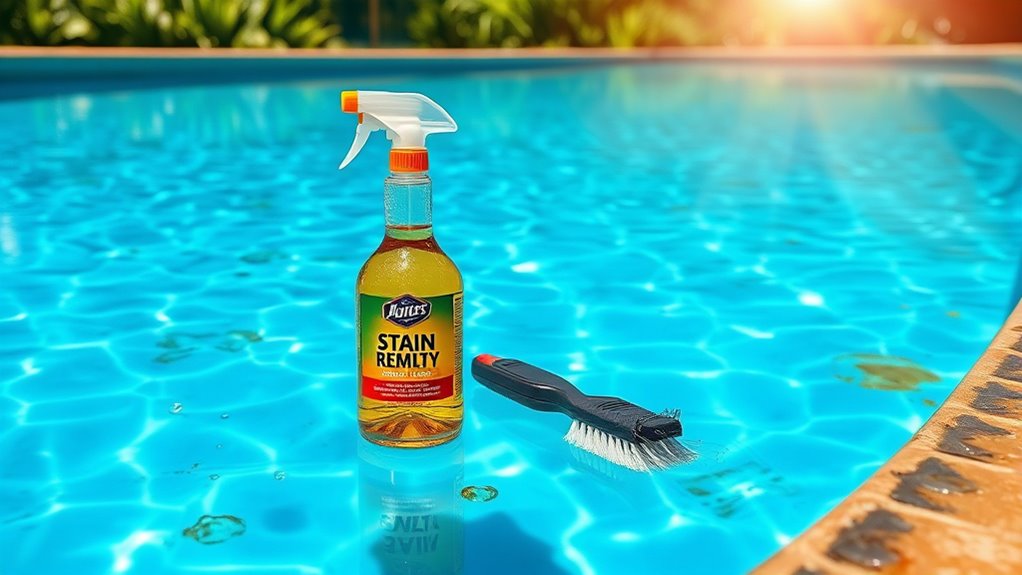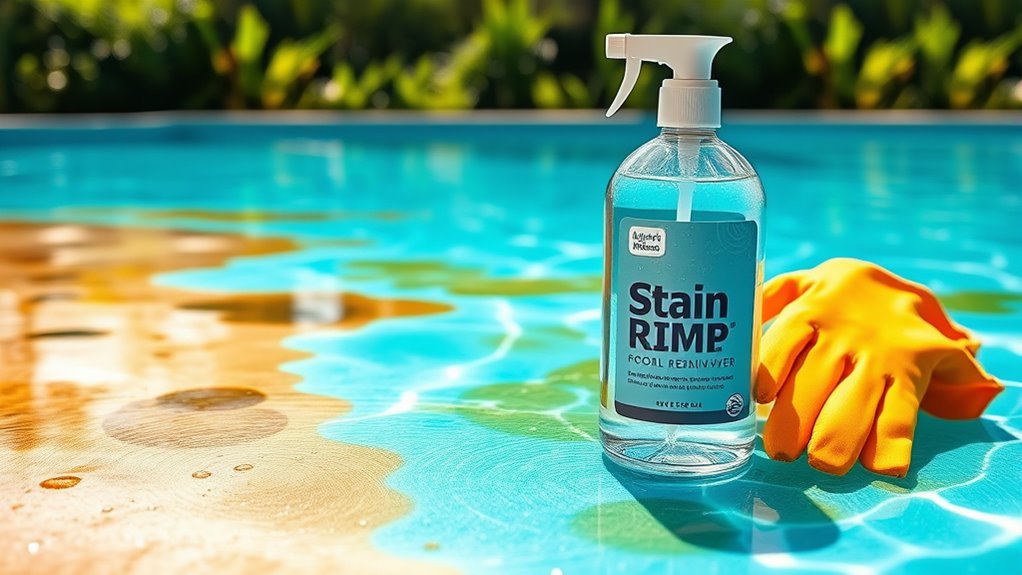To tackle pool discoloration, start by identifying the stain type—be it organic, mineral, or metallic. Regularly test and balance your water conditions to prevent further issues. Use chlorine shock for organic stains or metal sequestering agents for iron and copper. For tougher stains, brush and vacuum the affected areas. Routine maintenance can stop discoloration from returning. Want to guarantee your pool stays clear and inviting? There’s more to explore on effective stain removal techniques.
Key Takeaways
- Identify the type of stain (organic, mineral, or metallic) to choose the appropriate removal method effectively.
- Regularly test water conditions to maintain balanced pH and prevent future discoloration.
- Use chlorine shock for organic stains and metal sequestering agents for iron or copper stains.
- Employ physical removal techniques like brushing and vacuuming to enhance stain removal efficiency.
- Implement routine cleaning and professional maintenance to prevent recurring discoloration and maintain pool health.

When your pool starts showing discoloration, it can be frustrating, especially if you’re unsure how to tackle the issue. The first step is identifying the type of stain you’re dealing with. Stains can come from various sources, including organic materials like leaves and algae, mineral deposits from hard water, or even metallic sources like iron or copper. Knowing the stain’s color, size, and location will help you pinpoint its cause and choose the right treatment.
Once you’ve evaluated the stain, you’ll want to take into account your water conditions. Balanced pH, alkalinity, and calcium hardness are vital for maintaining a healthy pool and preventing additional stains. Using a testing kit, like the Suncoast Stain ID Kit, can help you accurately identify the type of stain you’re facing. Documenting the stain’s appearance is also wise for future reference, especially if you encounter similar issues down the road.
Chemical treatments are often the most effective way to remove stains. These treatments typically involve oxidation or reduction agents that target the stain-causing substances. For instance, chlorine shock works well for organic stains, while metal sequestering agents can tackle iron and copper stains. Remember, though, that incorrect dosages can harm pool surfaces or even pose risks to swimmers. If you’re using shock, pre-dissolve it in water, especially for vinyl liners, to protect your pool.
After applying the appropriate chemical treatment, don’t forget the importance of physical removal techniques. Brushing the stains with a stiff brush will help lift them from the surface, and running the pool pump for an extended period will disperse the treatment throughout the water. If stains persist, specialized vacuum heads can help remove stubborn residues from the pool bottom and walls.
To prevent future discoloration, make it a habit to regularly test and balance your pool water. Keeping your water conditions stable can prevent mineral precipitation and subsequent staining. Additionally, think about using stain barrier products to protect your surfaces from microorganism-related stains. Regular pool cleaning and professional maintenance can also help catch potential issues early.
In the end, choosing the right stain remover is essential. Different materials, such as vinyl or plaster, require specific treatments. By understanding the nature of your pool stains and following these guidelines, you can restore your pool to its sparkling glory and enjoy a clear, beautiful swimming environment again.
Frequently Asked Questions
What Causes Pool Discoloration in the First Place?
Pool discoloration happens due to various factors.
Organic materials like leaves and algae can stain surfaces, while metal corrosion introduces rust. High metal content in well water also contributes to discoloration.
Additionally, poor cleaning habits allow dirt and debris to settle. Lesser-known causes include high stabilizer levels and potassium permanganate from treatment systems.
Regular maintenance and cleaning can help you prevent these issues and keep your pool looking its best.
How Can I Prevent Stains From Forming in My Pool?
To prevent stains from forming in your pool, regularly test and balance your water’s pH, alkalinity, and calcium levels.
Skim debris daily and brush the walls and floor to minimize buildup. Vacuum weekly to remove dirt, and clean filters bi-weekly.
Use sequestrants to keep metals suspended and apply algaecides to control algae.
Adjust your maintenance routine with seasonal changes, ensuring proper circulation and filtration for ideal water quality.
Are Natural Stain Removers Effective for Pool Discoloration?
You’ll find that natural stain removers can be effective for pool discoloration, but they often take longer to show results compared to chemical options.
Ingredients like ascorbic and citric acid target metal stains, while enzymatic cleaners work wonders on organic debris.
Though they’re gentler on surfaces and safer for the environment, you’ll need to be patient and consistent with your application to achieve the desired results.
How Often Should I Check for Stains in My Pool?
Did you know that nearly 40% of pool owners face staining issues each season?
To keep your pool looking its best, check for stains at least twice a week, especially during peak usage.
After heavy rain or storms, inspect more frequently to catch any debris or discoloration early.
Maintaining a consistent inspection routine helps you avoid larger problems and guarantees your pool remains a rejuvenating oasis throughout the summer.
Can Pool Stains Affect Water Quality and Safety?
Yes, pool stains can definitely affect water quality and safety.
When you notice stains, it often means there’s an imbalance in your pool’s chemistry, which can lead to poor water clarity and create a breeding ground for harmful bacteria.
Stains can trap debris, complicating sanitation efforts and increasing health risks for swimmers.
Regular monitoring and maintenance are essential to keep your pool safe and enjoyable for everyone.
Don’t ignore those stains!
Conclusion
So, you’ve battled the green monster in your pool and survived the chaos of discoloration—congratulations! With your trusty stain removers in hand, you’re not just a swimmer; you’re a pool Picasso, splashing vibrant colors across your backyard oasis. Who needs a tropical paradise when you can have a Jackson Pollock masterpiece of algae and rust? Immerse yourself and embrace your inner artist; after all, nothing says luxury like a pool that resembles a modern art exhibit gone wrong!









